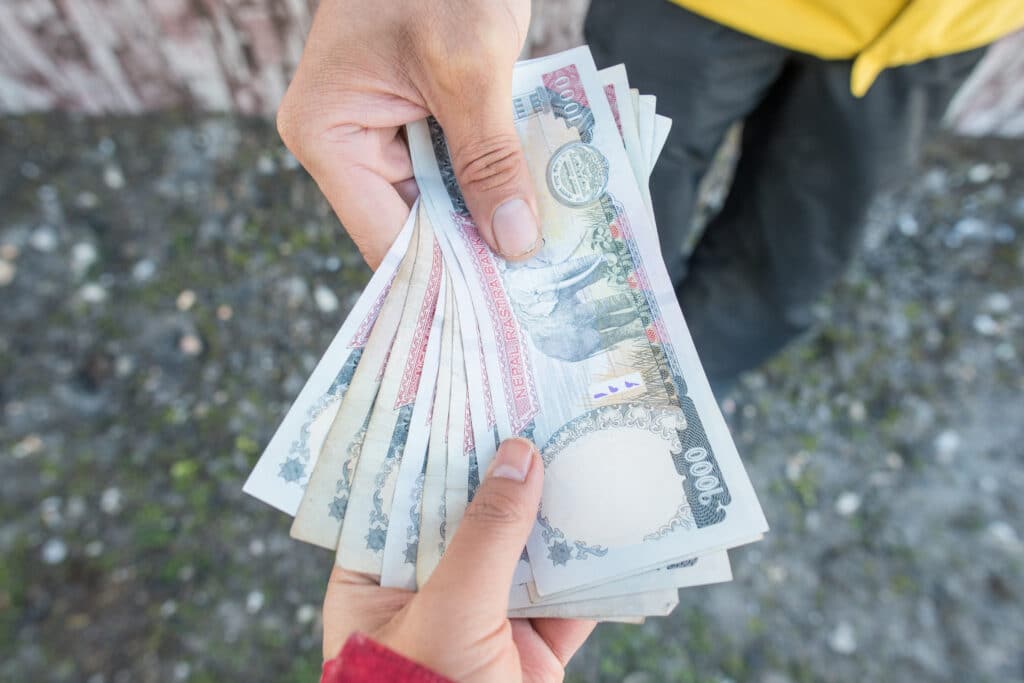If you plan to travel to Nepal or send money home, you’ll need to turn your USD, CAD, euros, or pounds into Nepalese rupees. Read on for a closer look at this important South Asian currency. The Nepalese rupee (NPR) is the official currency of Nepal. Introduced in 1932, the symbol of the rupee is रु. The rupee is subdivided into 100 paise. The NPR is issued by the Nepal Rastra Bank.
- Banknotes are printed in the following denominations: रु5, रु10, रु20, रु50, रु100, रु500, and रु1,000 are commonly used, while रु1, रु2, रु25, and रु250 are in circulation but are less frequently used.
- Coins are minted in the following denominations: रु1 and रु2 coins are commonly found, while 1, 5, 10, 25, 50 paise, रु5, and रु10 are in circulation but are less frequently used.
1. The exchange rate of NPR is pegged to the Indian rupee.
When it was introduced, the NPR replaced the previous currency, the Nepalese mohar. The exchange rate of the rupee is set against the Indian rupee (INR).
Before 1994, the NPR was pegged to the INR at 1 INR to 1.45 NPR. Since 1994, this rate has been adjusted from 1 INR to 1.60 NPR.
2. Banknotes showcase Nepal’s rich history and landscapes.
Released in 2012, the most recent series of banknotes feature images of Mount Everest along with other local symbols of natural and cultural significance.
In fact, Mount Everest is a prominent feature on all banknotes ranging from रु5 to रु1,000.

3. Each rupee bill has a distinct color.
With the redesign of rupee banknotes in 2012 came denominations with their own distinct colors. Designs changed slightly between 2012 and 2017, but the color palette has remained. Including depictions of Mount Everest, Nepalese rupee banknotes feature the following:
- रु5: lilac and pink banknotes featuring the Kasthamandap Temple on one side and a yak on the other.
- रु10: a brown and green note featuring Garud Narayan of the Changu Narayan temple on the obverse and an antelope and trees on the reverse.
- रु20: brown and orange banknotes with the Krishna Mandir Temple and Garuda atop pillar on one side and swamp deer, trees, and mountains on the other.
- रु50: a purple, green, and blue note featuring the Rama-Janaki temple of Janakpur on the obverse and a snow leopard on the reverse.
- रु100: a green and lilac bill featuring the temple of Taleju in Kathmandu on the obverse and a one-horned rhinoceros on the reverse.
- रु500: a brown and violet note featuring the god Indra and the Mount Amadablam and Thyangboche monastery on one side and tiger on the other.
- रु1,000: blue and gray notes with the Swayambhunath stupa and Harati temple featured on the obverse and twin Asian elephants on the reverse.
4. Paisa coins were once made from bullets.
In 1955, Nepal’s 4 paisa coin was minted from the rifle cartridge cases from World War II used by the Gurkha soldiers who fought against the Japanese in the Pacific.
Nepalis constructed these coins by removing the cartridge’s primer, in part to commemorate the courage and victory of the Gurkha soldiers.
More about Nepal
Nepal is a landlocked country in Asia, situated north of India and south of China. Nepal is home to 29.14 million people, with many people living in the capital city of Kathmandu. The official language is Nepali and is spoken by about 45% of the population, with smaller populations speaking Maithili, Bhojpuri, Tamang, Tharu, Newari, Bajjika, and Magar, among other languages.
Nepal gained admission to the United Nations in 1955. In 1991, the kingdom established a multiparty parliamentary system. In 2008, after a period of violence and turbulence with a strong Maoist insurgency, the monarchy in Nepal was dissolved, and the country declared a democratic republic.
Tourism represents a small but expanding industry in Nepal, especially in the Kathmandu Valley and around Mount Everest. Nepal’s cultural and artistic heritage is seen through the architecture and sculpture of the country’s many temples and religious sites.

